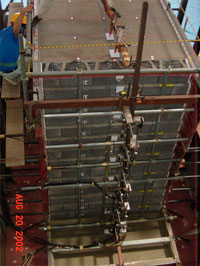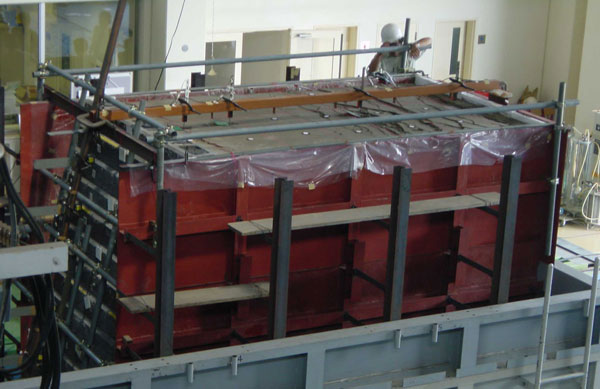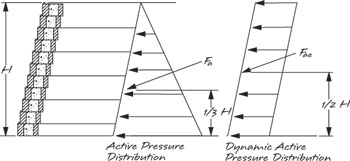Technical Newsletter
Issue 20
Project Information
Name:Gregg Anderson Academy
Product:AB Classic
Size: 3,942 ft² (366 m²)
Local Engineer: Johnson & Nielsen
Contractor: Homeland Engineers
Allan Block Manufacturer:Orco Block

In 2002 Columbia University and Allan Block performed testing on a full-scale seismic shake table at the National Research Institute in Tsukuba, Japan to better understand the behavior of geogrid reinforced soils and segmental retaining walls during seismic loading. Tests were conducted with accelerations that met or exceeded the recorded results of the Kobe earthquake (7.2 on the Richter scale) on January 17, 1995. The results helped mold the industry’s understanding of reinforced soil masses and segmental retaining walls.
AB Seismic Testing Executive Summary

Completed structure on shake table
Addressing Design Challenges in a Seismic Zone
The Gregg Anderson Academy is a K-8 school that first opened for the 2012-13 school year in the growing community of Palmdale, CA. Palmdale is a very hilly area and in order to facilitate the construction of the athletic fields, project engineers, Johnson and Nielsen Engineering Consultants, proposed an Allan Block segmental retaining wall ranging from 0 to 18 ft (5.5 m) in height. Allan Block, produced by Orco Block, was chosen because of the fact that segmental retaining walls designed with geogrid reinforcement perform better in high seismic areas than any other type of retaining wall system. The City of Palmdale is located in Antelope Valley which is the northern part of Los Angeles County, and has the southern segment of the San Andreas Fault running right along its southern edge. The Academy is located about 2 miles from the San Andreas Fault so the designers had to carefully analyze the seismicity of the site.
The southern segment of the San Andreas Fault begins to take a northward turn just outside of Palmdale. Seismologists say that this area experiences a seismic event in the magnitude of 8 on the Richter scale every 140 to 160 years.
Early in the design phase the soils engineers, Earth Systems of Southern California, analyzed the site soils and the seismic design criteria and also consider the slope stability of the site. Earth Systems determined that a seismic coefficient of 0.79g was required for the project. California has its own specific seismic requirements for design and this 0.79g was based off of the 2007 California Building Code.
Due to the wall heights, slopes above and site use, Johnson and Nielsen designed the top of wall to carry the lateral forces from a 6 ft (1.8 m) fence and called for a storm water swale directly behind the wall. Controlling top of wall overturning forces due to fences and managing site water are essential to the life of the wall. Johnson and Nielsen engineers tamed a high seismic site by utilizing the structural capabilities of the Allan Block product line, the only segmental retaining wall system to be tested in full-scale seismic shake table tests. These independent tests were conducted by researchers from Columbia University and the University of Delaware at the national research laboratories in Tsukuba, Japan.
Seismic Acceleration Coefficient
For the seismic design of segmental retaining walls (SRWs) it is important to identify the applicable seismic Acceleration coefficient (Ao) for your project location. The value of Ao used for the seismic design of SRWs typically ranges from 0.0g to 0.4g. There are many different codes that provide slight variations of how to determine the seismic coefficient and calculating this coefficient in accordance to your local building code is critical.
NCMA Design Methodology
The National Concrete Masonry Association (NCMA) defines the seismic coefficient (Ao) as the horizontal Peak Ground Acceleration (PGA), expressed as a fraction of the gravitational constant, g. The PGA accounts for the probability of an extreme event occurring within a predetermined life-cycle. The NCMA recommends that the values to be used for design are taken from the PGA mapped values presented by AASHTO, which consider a 90% probability of not being exceeded for a 50 year event (AASHTO 4th Edition/2007).
Seismic Coefficient by Local Building Code
AASHTO provides maps within Section 3 for identifying the applicable coefficient; however, your local code may require you to use an IBC referenced ASCE-7 map and calculation for determining the applicable coefficient. If your project is in Canada, the National Building Code of Canada also has coefficient tables organized by city and your local jurisdiction may require a calculation to determine the applicable coefficient. The values determined using these other design code methodologies differ from the AASHTO methodology; however, Allan Block recommends that you verify with your local building official to ensure that your methodology is in accordance to your local building code requirements.
To learn more about applying seismic forces to Allan Block segmental retaining walls, please download the AB Engineering Manual.
Dynamic Earth Pressure Distribution
A pseudo-static approach based on the Mononobe- Okabe (M-O) method is used to calculate the total dynamic active earth force (Fae). The equation is similar to the active earth pressure equation except that it uses the PGA to determine the acceleration coefficient,Kh and the dynamic earth pressure coefficient, Kaer.
It was determined during the 2002 Columbia University testing that the magnitude of the dynamic earth pressure should be applied to the wall as a rectangular distribution, radically changing the old theoretical inverted triangle method. The National Concrete Masonry Association (NCMA), FHWA and AASHTO have all adopted this methodology change.
Building in a Seismic Zone
A wall that is installed in a seismic zone is likely to have several noticeable differences from those that are installed in non-seismic regions. Here are a few notables and why they are recommended for seismic zone construction:
- Closer spacing of geogrid: From full-scale seismic testing performed by Columbia University in cooperation with Allan Block, the segmental retaining wall industry confirmed that geogrid within a soil mass does not behave like an earth anchor as it was previously thought. Instead, geogrid acts as reinforcement for a soil mass causing the soil and geogrid to interact as a coherent mass. It was because of this testing that the entire industry lowered it suggested maximum geogrid spacing from 4-course (32 in. (800mm)) down to 3-course (24 in. (600mm)) for all types of segmental walls. Another significant result of this research was the fact that a wall built using a 2-course grid spacing using lighter weight geogrids builds a significantly stronger, more stable wall than does a wall using a 3-course spacing with stronger grids. These results were so clear and so dramatic that Allan Block suggests using lightweight grids with a 2-course maximum spacing for all wall designs.
- Extension of top layer(s) of grid: For seismic designed walls, the embedment length requirement for the top geogrid layers is longer than for statically designed walls. Therefore it is common in seismic regions to see the top one or more layers longer than the lower grid lengths. Longer top grid layers can bring added benefits beyond the seismic requirements. The Columbia University testing also confirmed that the reinforced coherent mass can potentially behave independently from the native soil mass directly behind the reinforced zone. When this occurs, there is a potential for surface cracking at the back of the reinforced zone. By extending the top layer(s) of geogrid, the potential for surface cracking is greatly diminished.
- Use of select backfill: In all types of walls in static and dynamic areas, it is common to use site soils in the reinforced zone, behind the wall rock zone. In areas where high seismic designs are required, it is not uncommon to see engineers specify a select backfill material to the back of the reinforced zone. This is because a select backfill will likely have a higher internal friction angle than the site soils and thus provide a higher interact with the geogrid layers.
One of the authors, Professor Hoe Ling, of the University of Columbia/Allan Block seismic testing wrote, “When properly designed and constructed, these systems seem well suited for handling seismic conditions. The wall facing, soil mass and geosynthetic reinforcement all moved in phase with the earthquake induced forces. Structures that are both flexible and coherent are ideal for these conditions”.

General appearance of the Allan Block wall after the shaking with a horizontal load of 0.8g and a vertical load of 0.4g. The wall did not fail, but had a horizontal displacement of less than 1.9-inches (50mm) with the largest settlement of less than 1.6-inches (40mm) occurring behind the top layer of geogrid. You can see the surface cracks behind the geogrid reinforcement within the retained soil zone.





